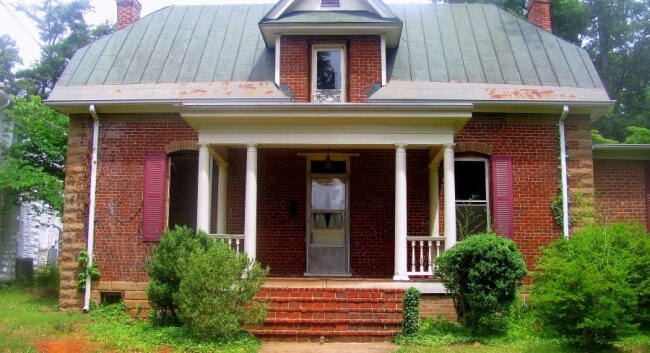Unhipping? JPA Colonial Revival may not be revived
Last Week, the Hook's cover story [Extreme Makeover: rich edition] showed how wealthy property owners have taken advantage of the State's generous Historic Rehabilitation Tax Credit Program, receiving hundreds of thousands in tax breaks for fixing up their old homes. Over on the east side of Jefferson Park Avenue, home to some of the City's most attractive residences (and where the parallel roads are now oddly traffic-free due to the bridge reconstruction), there stands what appears to be an ideal candidate for a rehabilitation program: a uninhabited circa 1912 Colonial Revival-style one and one-half story, 2,753 square-foot home purchased last September and in need of some TLC.
However, despite paying close to $400,000 for the property, its owner, local businessman J. Kermit Anderson, recently applied for a demolition permit. The Hook left messages with Anderson, curious about what he planned to build at what has been known as number 2424, and whether he had considered rehabilitating the place with the help of historic tax credits, but he has yet to respond.
However, according to City officials, Anderson has no interest in saving the old house.
"The property isn't protected. I spoke to Mr. Anderson to see if he would reconsider the demolition," says City Preservation Planner Mary Joy Scala, "but he says the building is in very bad condition structurally."
However, according to a historic survey done in early 2010, it was a "well-preserved" brick residence that contributed to the Fry Springs historic district and one of the few buildings in the neighborhood with a "jerkinhead" or hipped roof. Instead of rising to a point on the north and south sides of the house, the roof (standing-seam metal) appears to be clipped where the two chimneys rise. This was a popular feature on many Victorian-style houses and bungalows. It also has a modern, two-bay, one-story brick wing on the south side.
The brickwork is interesting as well, featuring a 7-course American bond layout and distinctive rusticated block corner cornerstones, known as quoins, which typically give an impression of added strength to the corners of brick buildings. Arches in a lighter color brick pass over the one-over-one sash widows and the front door.
The house also features a number of other interesting architectural details, like a central brick wall dormer that contains a door topped by a pedimented gable, a three-bay front porch with Tuscan columns, and Victorian-style turned wood balusters and a flat roof balcony. A rear hip-roofed wing of 8-course American bond extends to the rear and features a covered porch.
With the house set back from the street, and with a big magnolia and mature boxwoods on the approximately 1-acre property, it still looks rather stately, if not haunted, in its present condition.

5 comments
NO NO NO!!! This house should be restored, NOT demolished!!!!!
i agree with you Denise! money talks but doesn't make you smart......we are losing too much of our history/historical places! guess folks just don't realize...
The director of economic development for Albemarle County said at the last BOS meeting Wed. night that a business they were courting mentioned our communities attention to historic preservation as a plus. This wouldn't help that selling point in the future.
NancyDrew:
Unfortunately, our community's attention to historic preservation is one more area in which self-congratulatory rhetoric masks a reprehensibly sorry record.
Other communities opt for practicality over pretence and thereby rack up much better records. In Petersburg, for instance, the Historic Petersburg Foundation has held real estate fairs in which vulnerable properties are shown with advisors on site for folks who want to learn about what rehab would entail, how to secure financing, etc. Members of HPF have even done regular hands-on chores for historic house owners who can't afford maintenance and repairs on their own.
The JPA house showcased here is obviously a gem. If it were in Staunton or Richmond or Lynchburg, someone would be stepping forward to see that it's not lost from an historic property inventory that was never extensive to begin with.
How eerie to see this house featured in your article. It was my family's home for three generations, from the late 1930s when my grandfather bought it, until we moved my mother out recently to an apartment. My family had not owned it for about 12 years, since my father died, but Mom sold it to a neighbor who rented it back to her at an affordable rate. She moved out when the house was sold to the current owner. From the photo, it looks like some renovation work had already begun, and then possibly abandoned. One window looks like it has already been removed. The house had some issues when my father moved us into it in the 1960s, when I was still in high school, and over the years he could not keep up with the escalating need for repairs, nor could the most recent owner over the last 12 years despite his good faith and extensive efforts. In the last few years, it really began to show its age. It will need extensive work, I can assure you, and might have to be largely gutted in order for the exterior to be saved. I am all for historic renovation, but unless the government owns it, it is not the government's decision to make, ultimately. The property is exceptional, and a fine house can be built there. Let the owner decide what he wants to do. Sometimes, a building just gets old, and there is no economically feasible way to keep it going, which is why there are so few 100-year old houses around.